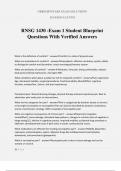©BRIGHTSTARS EXAM SOLUTIONS
11/14/2024 12:19 PM
RNSG 1430 -Exam 1 Student Blueprint
Questions With Verified Answers
What is the definition of comfort? - answer✔Comfort is a state of physical ease.
What are antecedents to comfort? - answer✔Antecedents: effective circulatory system, ability
to distinguish comfort and discomfort, intact neurological/sensory system.
What are attributes of comfort? - answer✔Attributes: Zero pain, being comfortable, relaxed
body posture/facial expressions, vital signs WNL
What conditions which place a patient at risk for impaired comfort? - answer✔Pain experience:
Age, decreased mobility, surgery/procedures, functional ability, Mood/Affect, cognitive
function, anxiety/fear, culture, and prior experiences.
Procedural pain: Wound dressing changes, physical therapy and post-operative pain. Best to
administer pain meds prior to interventions.
What are the categories for pain? - answer✔Pain is categorized by duration (acute or chronic)
or by origin (nociceptive or neuropathic) Pain can also be described by duration, localization,
source, transmission, etiology. DDD is example of neuropathic pain.
What are negative consequences of chronic pain?` - answer✔Depression (negative
mood/affect), tissue damage, disturbed sleep patterns, changes in nutrition (loss of appetite or
binge eating[1] ), decline in cognitive process, impaired mobility, accidental drug overdose or
addiction, developmental issues if pain starts in youth, cardiovascular issues.
What medications are effective for treating neuropathic pain? - answer✔NSAIDs (ibuprofen,
naproxen), acetaminophen, aspirin, Adjuvant drugs like antidepressants (nortriptyline,
duloxetine), anticonvulsants (gabapentin)
What is nociceptive pain? - answer✔Nociceptive pain is due to tissue damage and can be
somatic or visceral.
1|Page
, ©BRIGHTSTARS EXAM SOLUTIONS
11/14/2024 12:19 PM
What types of nociceptive pain exist? - answer✔Somatic: bones, joints, skin, and muscle pain.
Described as[1] throbbing, aching, sharp and can be well localized. Ex: breaking a bone/joint
damage, cuts, burns, pulled muscle, etc.
Visceral: is deep in organs of the thorax, abdomen, and cranium. Described as sharp, stabbing,
throbbing, not well localized. Ex: bladder distention (stretching), obstruction/inflammation in
hollow organs (GI tract, IBS, Crohn's disease) like severe constipation, menstrual cramps.
What are examples of non-pharmacological pain interventions? - answer✔Acupuncture,
chiropractic manipulation, hot/cold compress, relaxation (breathing techniques, massage,
music), distraction, laughter, yoga, and TENS unit.
How should acute post op pain be assessed and managed? - answer✔Assess patient every 15
mins for 1st hour, every 30 mins for next 2hrs and q4h for 24 hrs
Assess Vitals, Airway (Respiratory Function), Cardiovascular function (shock, hemorrhaging,
hypo/hypertension), Level of consciousness (responsiveness), Skin color/integrity.
Assess Pain and administer prescribed analgesics ATC (around the clock) if possible. Reassess
patients' pain level 30 mins after taking the drug. If patient has PCA pump try to slowly wean
them off and get them to take oral pain meds.
How can physical therapy assist with patient comfort after an arthroplasty? - answer✔In
arthroplasty, diseased joint components are replaced. Rehabilitation with physical therapy that
is initiated within the first 24 hours is associated with decreased hospital length of stay and
improved balance and gait function
What are examples of neuropathic pain? - answer✔Phantom leg pain (peripheral), pain from
spinal cord injury (central), diabetic neuropathy, Trigeminal neuralgia, Postherpetic neuralgia,
causalgia, fibromyalgia
What are some collaborative therapies for osteoarthritis? - answer✔Work with physicians and
other advanced practice professionals, physical therapists, and other health care professionals
to maintain joint mobility.
2|Page
, ©BRIGHTSTARS EXAM SOLUTIONS
11/14/2024 12:19 PM
Patient education is directed to the patient's mastery of an exercise (i.e. Tai Chi, yoga, weight-
bearing) and care programs (i.e. P.T.; O.T.), which fosters tissue repair and maximal
independence in ADLs.
What are common Postoperative Pain Management Medication Effects? - answer✔● Poor
respiratory function
● Nausea and/or vomiting
● Constipation
● Urinary retention
● Drowsiness
● Impaired cognition
What is the subjective experience of acute pain? - answer✔Acute pain is the state in which an
individual experiences and reports the presence of severe discomfort lasting from 1 second to
less than 6 months.
Patient must report or demonstrate signs of discomfort, including, but not limited to:
● Nausea and/or vomiting
● Itching
● Crying
● Moaning
Facial mask of pain or guarded position[1]
Additional information:
3 types of pain responses- behavioral, physiological, and affective (emotional)
What effects can chronic pain have in the older population? - answer✔Because of chronic
illness, an older adult may need to adjust to living with some pain.
Pain should not be assumed to be a normal consequence of aging, but it is often experienced by
older adults and frequently undertreated.
3|Page




